warning JEEP RENEGADE 2018 Owner handbook (in English)
[x] Cancel search | Manufacturer: JEEP, Model Year: 2018, Model line: RENEGADE, Model: JEEP RENEGADE 2018Pages: 356, PDF Size: 6.11 MB
Page 117 of 356
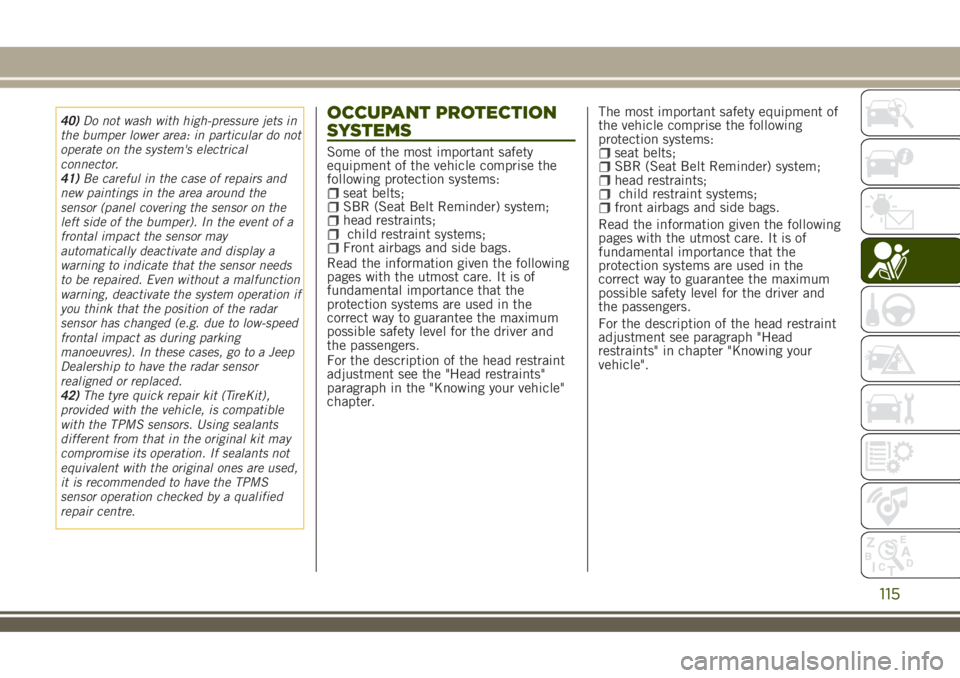
40)Do not wash with high-pressure jets in
the bumper lower area: in particular do not
operate on the system's electrical
connector.
41)Be careful in the case of repairs and
new paintings in the area around the
sensor (panel covering the sensor on the
left side of the bumper). In the event of a
frontal impact the sensor may
automatically deactivate and display a
warning to indicate that the sensor needs
to be repaired. Even without a malfunction
warning, deactivate the system operation if
you think that the position of the radar
sensor has changed (e.g. due to low-speed
frontal impact as during parking
manoeuvres). In these cases, go to a Jeep
Dealership to have the radar sensor
realigned or replaced.
42)The tyre quick repair kit (TireKit),
provided with the vehicle, is compatible
with the TPMS sensors. Using sealants
different from that in the original kit may
compromise its operation. If sealants not
equivalent with the original ones are used,
it is recommended to have the TPMS
sensor operation checked by a qualified
repair centre.OCCUPANT PROTECTION
SYSTEMS
Some of the most important safety
equipment of the vehicle comprise the
following protection systems:
seat belts;SBR (Seat Belt Reminder) system;head restraints;child restraint systems;Front airbags and side bags.
Read the information given the following
pages with the utmost care. It is of
fundamental importance that the
protection systems are used in the
correct way to guarantee the maximum
possible safety level for the driver and
the passengers.
For the description of the head restraint
adjustment see the "Head restraints"
paragraph in the "Knowing your vehicle"
chapter.The most important safety equipment of
the vehicle comprise the following
protection systems:
seat belts;SBR (Seat Belt Reminder) system;head restraints;child restraint systems;front airbags and side bags.
Read the information given the following
pages with the utmost care. It is of
fundamental importance that the
protection systems are used in the
correct way to guarantee the maximum
possible safety level for the driver and
the passengers.
For the description of the head restraint
adjustment see paragraph "Head
restraints" in chapter "Knowing your
vehicle".
115
Page 119 of 356
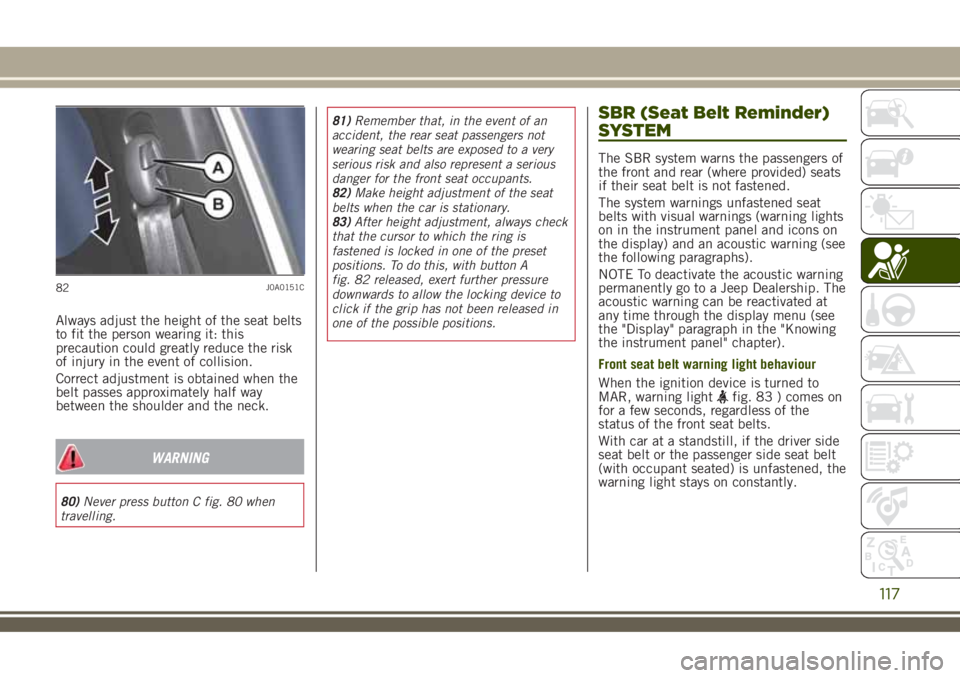
Always adjust the height of the seat belts
to fit the person wearing it: this
precaution could greatly reduce the risk
of injury in the event of collision.
Correct adjustment is obtained when the
belt passes approximately half way
between the shoulder and the neck.
WARNING
80)Never press button C fig. 80 when
travelling.81)Remember that, in the event of an
accident, the rear seat passengers not
wearing seat belts are exposed to a very
serious risk and also represent a serious
danger for the front seat occupants.
82)Make height adjustment of the seat
belts when the car is stationary.
83)After height adjustment, always check
that the cursor to which the ring is
fastened is locked in one of the preset
positions. To do this, with button A
fig. 82 released, exert further pressure
downwards to allow the locking device to
click if the grip has not been released in
one of the possible positions.
SBR (Seat Belt Reminder)
SYSTEM
The SBR system warns the passengers of
the front and rear (where provided) seats
if their seat belt is not fastened.
The system warnings unfastened seat
belts with visual warnings (warning lights
on in the instrument panel and icons on
the display) and an acoustic warning (see
the following paragraphs).
NOTE To deactivate the acoustic warning
permanently go to a Jeep Dealership. The
acoustic warning can be reactivated at
any time through the display menu (see
the "Display" paragraph in the "Knowing
the instrument panel" chapter).
Front seat belt warning light behaviour
When the ignition device is turned to
MAR, warning light
fig. 83 ) comes on
for a few seconds, regardless of the
status of the front seat belts.
With car at a standstill, if the driver side
seat belt or the passenger side seat belt
(with occupant seated) is unfastened, the
warning light stays on constantly.
82J0A0151C
117
Page 120 of 356
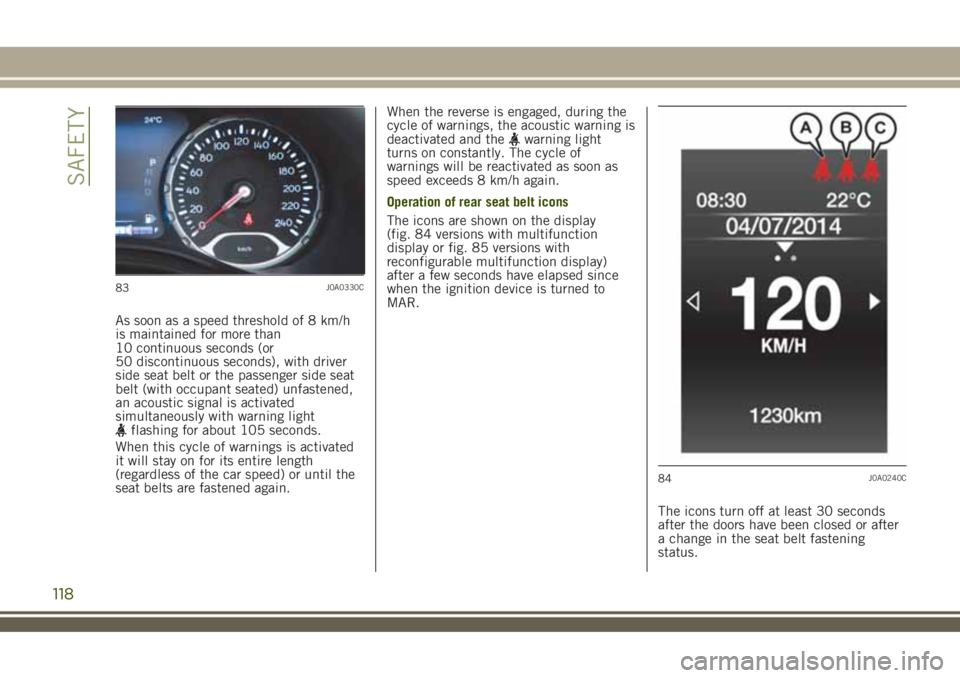
As soon as a speed threshold of 8 km/h
is maintained for more than
10 continuous seconds (or
50 discontinuous seconds), with driver
side seat belt or the passenger side seat
belt (with occupant seated) unfastened,
an acoustic signal is activated
simultaneously with warning light
flashing for about 105 seconds.
When this cycle of warnings is activated
it will stay on for its entire length
(regardless of the car speed) or until the
seat belts are fastened again.When the reverse is engaged, during the
cycle of warnings, the acoustic warning is
deactivated and the
warning light
turns on constantly. The cycle of
warnings will be reactivated as soon as
speed exceeds 8 km/h again.
Operation of rear seat belt icons
The icons are shown on the display
(fig. 84 versions with multifunction
display or fig. 85 versions with
reconfigurable multifunction display)
after a few seconds have elapsed since
when the ignition device is turned to
MAR.
The icons turn off at least 30 seconds
after the doors have been closed or after
a change in the seat belt fastening
status.
83J0A0330C
84J0A0240C
118
SAFETY
Page 121 of 356

The icons shown on the display indicate:A: rear left seat belt;B: rear central seat belt;C: rear right seat belt.
NOTE On versions equipped with
multifunction display, if a seat belt is
unfastened, the
icon lights up.
The icons are displayed according to the
corresponding seat belts in the rear
seats, and stay on for about 30 seconds
from the last seat belt status change:
if the seat belt is fastenedthe
corresponding icon will be green;
if the seat belt is unfastenedthe
corresponding icon will be red.
If a rear seat belt is unfastened, an
acoustic warning (3 "beeps") will beactivated along with the relevant icon
lighting up in the display.
Furthermore the icons will light up again
for 90 seconds each time one of the rear
doors is closed.
The icon will turn green after the
corresponding seat belt has been
fastened.
The rear seat icons will go out, regardless
of the state of the belt (red icon or green
icon), approximately 30 seconds after the
last signal.
IMPORTANT NOTES
As far as the rear seats are concerned,
the SBR system will only indicate
whether the seat belts are unfastened
(red icon) or fastened (green icon), not
the presence of any passengers.
The warning lights/icons are all off if all
seat belts (front and rear) are fastened
when the ignition device is at MAR.
For the rear seats, the icons will activate
a few seconds after the ignition device
has been turned to MAR, regardless of
the status of the seat belts (even if the
seat belts are all fastened).
All the warning lights/icons will come on
when at least one belt changes from
fastened to unfastened status or vice
versa.
PRETENSIONERS
84) 85) 86) 87)43)
The vehicle is equipped with front seat
belt pretensioners, which draw back the
seat belts by several centimetres in the
event of a strong frontal impact. This
guarantees the perfect adherence of the
seat belts to the occupant's bodies before
the retention action begins.
It is evident that the pretensioners have
been activated when the belt withdraws
toward the retractor.
This vehicle is also equipped with a
second pretensioner (fitted in the kick
plate area). Its activation is signalled by
the shortening of the metal cable.
A slight discharge of smoke may be
produced during the activation of the
pretensioner which is not harmful and
does not indicate any fire hazard.
The pretensioner does not require any
maintenance or lubrication: any changes
to its original conditions will invalidate
its efficiency.
If, due to unusual natural events (floods,
sea storms, etc.), the device has been
affected by water and/or mud, contact a
Jeep Dealership to have it replaced.
IMPORTANT To obtain the highest
degree of protection from the action of
85J0A0245C
119
Page 123 of 356
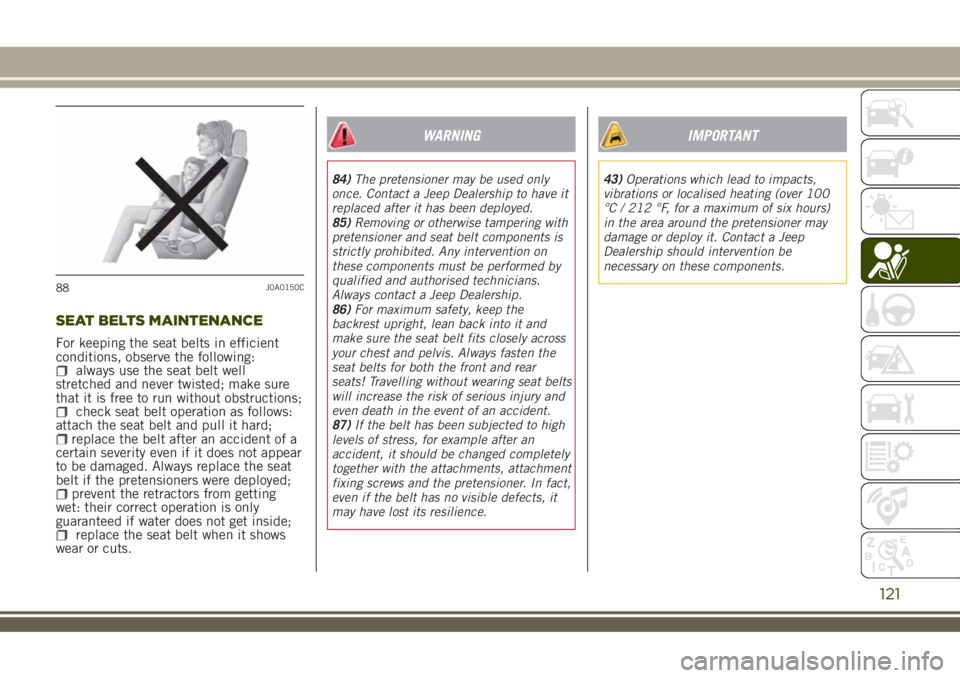
SEAT BELTS MAINTENANCE
For keeping the seat belts in efficient
conditions, observe the following:
always use the seat belt well
stretched and never twisted; make sure
that it is free to run without obstructions;
check seat belt operation as follows:
attach the seat belt and pull it hard;
replace the belt after an accident of a
certain severity even if it does not appear
to be damaged. Always replace the seat
belt if the pretensioners were deployed;
prevent the retractors from getting
wet: their correct operation is only
guaranteed if water does not get inside;
replace the seat belt when it shows
wear or cuts.
WARNING
84)The pretensioner may be used only
once. Contact a Jeep Dealership to have it
replaced after it has been deployed.
85)Removing or otherwise tampering with
pretensioner and seat belt components is
strictly prohibited. Any intervention on
these components must be performed by
qualified and authorised technicians.
Always contact a Jeep Dealership.
86)For maximum safety, keep the
backrest upright, lean back into it and
make sure the seat belt fits closely across
your chest and pelvis. Always fasten the
seat belts for both the front and rear
seats! Travelling without wearing seat belts
will increase the risk of serious injury and
even death in the event of an accident.
87)If the belt has been subjected to high
levels of stress, for example after an
accident, it should be changed completely
together with the attachments, attachment
fixing screws and the pretensioner. In fact,
even if the belt has no visible defects, it
may have lost its resilience.
IMPORTANT
43)Operations which lead to impacts,
vibrations or localised heating (over 100
°C / 212 °F, for a maximum of six hours)
in the area around the pretensioner may
damage or deploy it. Contact a Jeep
Dealership should intervention be
necessary on these components.
88J0A0150C
121
Page 138 of 356
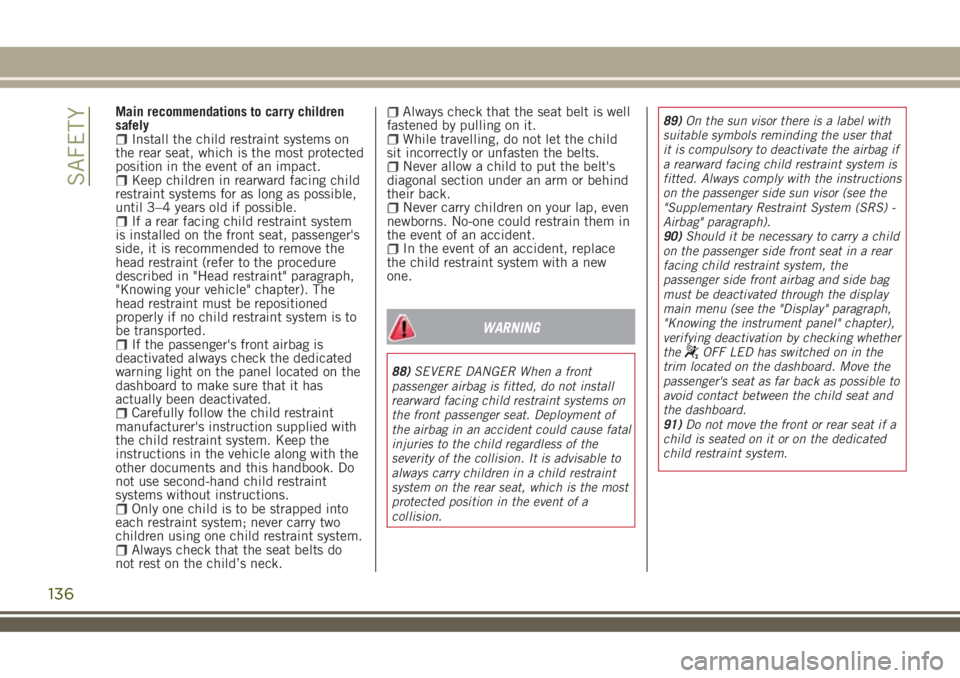
Main recommendations to carry children
safely
Install the child restraint systems on
the rear seat, which is the most protected
position in the event of an impact.
Keep children in rearward facing child
restraint systems for as long as possible,
until 3–4 years old if possible.
If a rear facing child restraint system
is installed on the front seat, passenger's
side, it is recommended to remove the
head restraint (refer to the procedure
described in "Head restraint" paragraph,
"Knowing your vehicle" chapter). The
head restraint must be repositioned
properly if no child restraint system is to
be transported.
If the passenger's front airbag is
deactivated always check the dedicated
warning light on the panel located on the
dashboard to make sure that it has
actually been deactivated.
Carefully follow the child restraint
manufacturer's instruction supplied with
the child restraint system. Keep the
instructions in the vehicle along with the
other documents and this handbook. Do
not use second-hand child restraint
systems without instructions.
Only one child is to be strapped into
each restraint system; never carry two
children using one child restraint system.
Always check that the seat belts do
not rest on the child’s neck.
Always check that the seat belt is well
fastened by pulling on it.
While travelling, do not let the child
sit incorrectly or unfasten the belts.
Never allow a child to put the belt's
diagonal section under an arm or behind
their back.
Never carry children on your lap, even
newborns. No-one could restrain them in
the event of an accident.
In the event of an accident, replace
the child restraint system with a new
one.
WARNING
88)SEVERE DANGER When a front
passenger airbag is fitted, do not install
rearward facing child restraint systems on
the front passenger seat. Deployment of
the airbag in an accident could cause fatal
injuries to the child regardless of the
severity of the collision. It is advisable to
always carry children in a child restraint
system on the rear seat, which is the most
protected position in the event of a
collision.89)On the sun visor there is a label with
suitable symbols reminding the user that
it is compulsory to deactivate the airbag if
a rearward facing child restraint system is
fitted. Always comply with the instructions
on the passenger side sun visor (see the
"Supplementary Restraint System (SRS) -
Airbag" paragraph).
90)Should it be necessary to carry a child
on the passenger side front seat in a rear
facing child restraint system, the
passenger side front airbag and side bag
must be deactivated through the display
main menu (see the "Display" paragraph,
"Knowing the instrument panel" chapter),
verifying deactivation by checking whether
the
OFF LED has switched on in the
trim located on the dashboard. Move the
passenger's seat as far back as possible to
avoid contact between the child seat and
the dashboard.
91)Do not move the front or rear seat if a
child is seated on it or on the dedicated
child restraint system.
136
SAFETY
Page 142 of 356
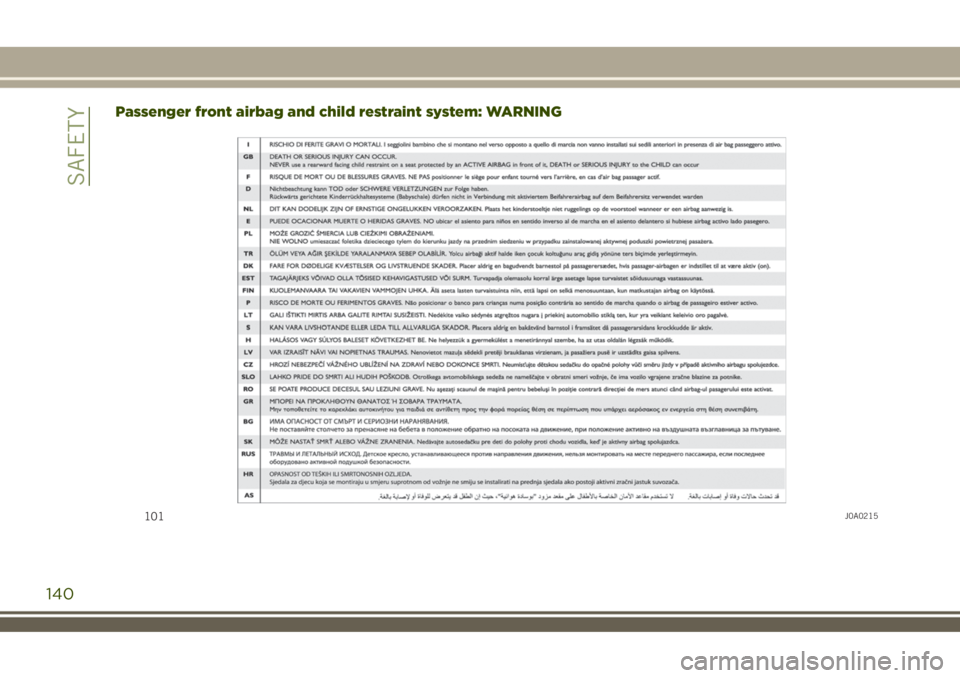
Passenger front airbag and child restraint system: WARNING
101J0A0215
140
SAFETY
Page 144 of 356
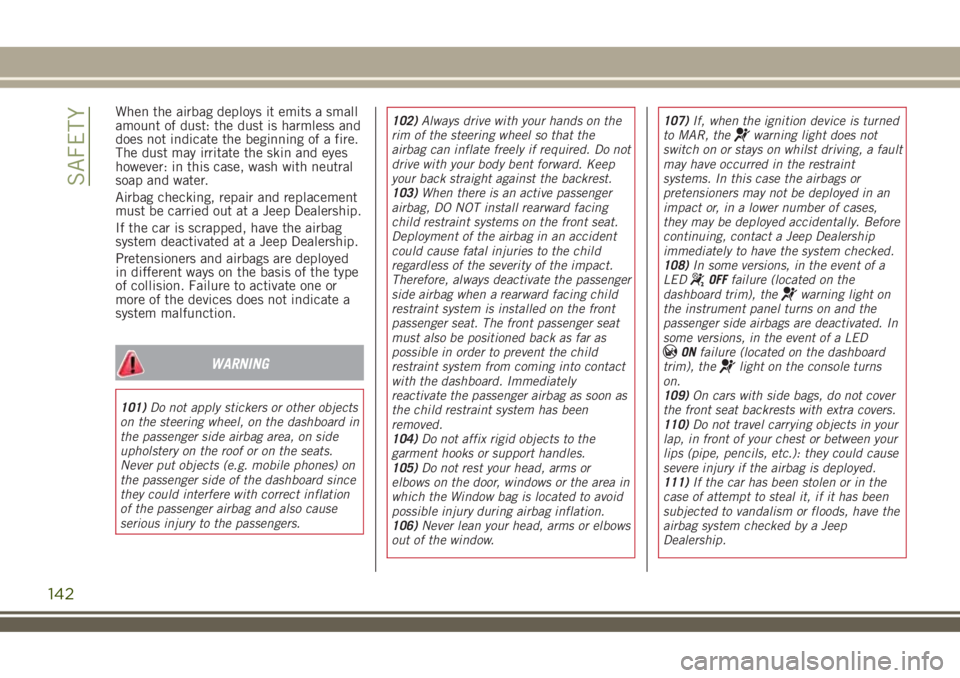
When the airbag deploys it emits a small
amount of dust: the dust is harmless and
does not indicate the beginning of a fire.
The dust may irritate the skin and eyes
however: in this case, wash with neutral
soap and water.
Airbag checking, repair and replacement
must be carried out at a Jeep Dealership.
If the car is scrapped, have the airbag
system deactivated at a Jeep Dealership.
Pretensioners and airbags are deployed
in different ways on the basis of the type
of collision. Failure to activate one or
more of the devices does not indicate a
system malfunction.
WARNING
101)Do not apply stickers or other objects
on the steering wheel, on the dashboard in
the passenger side airbag area, on side
upholstery on the roof or on the seats.
Never put objects (e.g. mobile phones) on
the passenger side of the dashboard since
they could interfere with correct inflation
of the passenger airbag and also cause
serious injury to the passengers.102)Always drive with your hands on the
rim of the steering wheel so that the
airbag can inflate freely if required. Do not
drive with your body bent forward. Keep
your back straight against the backrest.
103)When there is an active passenger
airbag, DO NOT install rearward facing
child restraint systems on the front seat.
Deployment of the airbag in an accident
could cause fatal injuries to the child
regardless of the severity of the impact.
Therefore, always deactivate the passenger
side airbag when a rearward facing child
restraint system is installed on the front
passenger seat. The front passenger seat
must also be positioned back as far as
possible in order to prevent the child
restraint system from coming into contact
with the dashboard. Immediately
reactivate the passenger airbag as soon as
the child restraint system has been
removed.
104)Do not affix rigid objects to the
garment hooks or support handles.
105)Do not rest your head, arms or
elbows on the door, windows or the area in
which the Window bag is located to avoid
possible injury during airbag inflation.
106)Never lean your head, arms or elbows
out of the window.107)If, when the ignition device is turned
to MAR, the
warning light does not
switch on or stays on whilst driving, a fault
may have occurred in the restraint
systems. In this case the airbags or
pretensioners may not be deployed in an
impact or, in a lower number of cases,
they may be deployed accidentally. Before
continuing, contact a Jeep Dealership
immediately to have the system checked.
108)In some versions, in the event of a
LED
OFFfailure (located on the
dashboard trim), thewarning light on
the instrument panel turns on and the
passenger side airbags are deactivated. In
some versions, in the event of a LED
ONfailure (located on the dashboard
trim), thelight on the console turns
on.
109)On cars with side bags, do not cover
the front seat backrests with extra covers.
110)Do not travel carrying objects in your
lap, in front of your chest or between your
lips (pipe, pencils, etc.): they could cause
severe injury if the airbag is deployed.
111)If the car has been stolen or in the
case of attempt to steal it, if it has been
subjected to vandalism or floods, have the
airbag system checked by a Jeep
Dealership.
142
SAFETY
Page 145 of 356
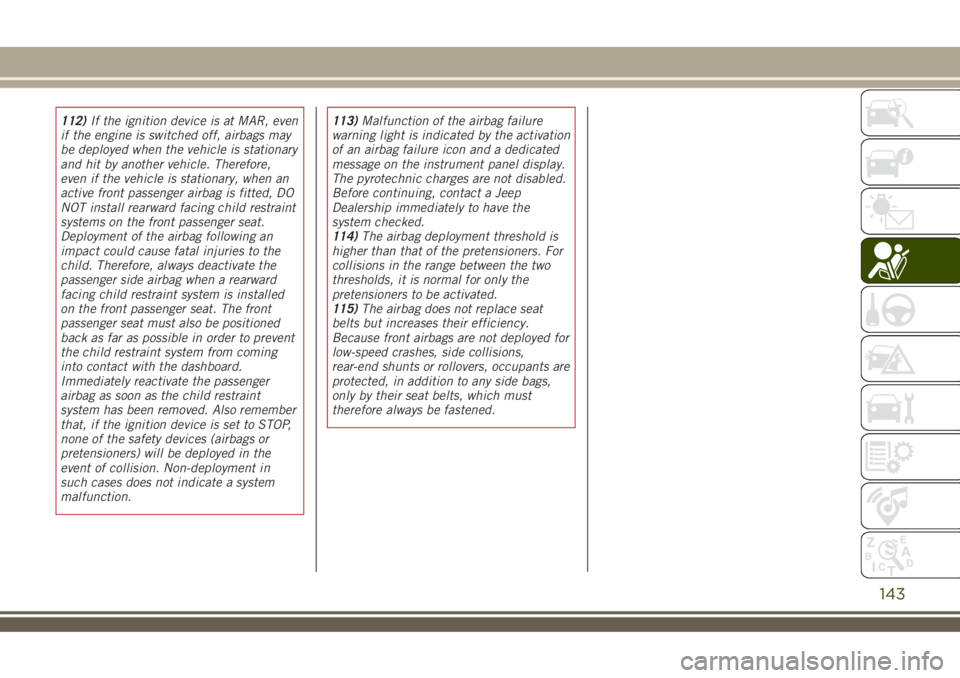
112)If the ignition device is at MAR, even
if the engine is switched off, airbags may
be deployed when the vehicle is stationary
and hit by another vehicle. Therefore,
even if the vehicle is stationary, when an
active front passenger airbag is fitted, DO
NOT install rearward facing child restraint
systems on the front passenger seat.
Deployment of the airbag following an
impact could cause fatal injuries to the
child. Therefore, always deactivate the
passenger side airbag when a rearward
facing child restraint system is installed
on the front passenger seat. The front
passenger seat must also be positioned
back as far as possible in order to prevent
the child restraint system from coming
into contact with the dashboard.
Immediately reactivate the passenger
airbag as soon as the child restraint
system has been removed. Also remember
that, if the ignition device is set to STOP,
none of the safety devices (airbags or
pretensioners) will be deployed in the
event of collision. Non-deployment in
such cases does not indicate a system
malfunction.113)Malfunction of the airbag failure
warning light is indicated by the activation
of an airbag failure icon and a dedicated
message on the instrument panel display.
The pyrotechnic charges are not disabled.
Before continuing, contact a Jeep
Dealership immediately to have the
system checked.
114)The airbag deployment threshold is
higher than that of the pretensioners. For
collisions in the range between the two
thresholds, it is normal for only the
pretensioners to be activated.
115)The airbag does not replace seat
belts but increases their efficiency.
Because front airbags are not deployed for
low-speed crashes, side collisions,
rear-end shunts or rollovers, occupants are
protected, in addition to any side bags,
only by their seat belts, which must
therefore always be fastened.
143
Page 147 of 356
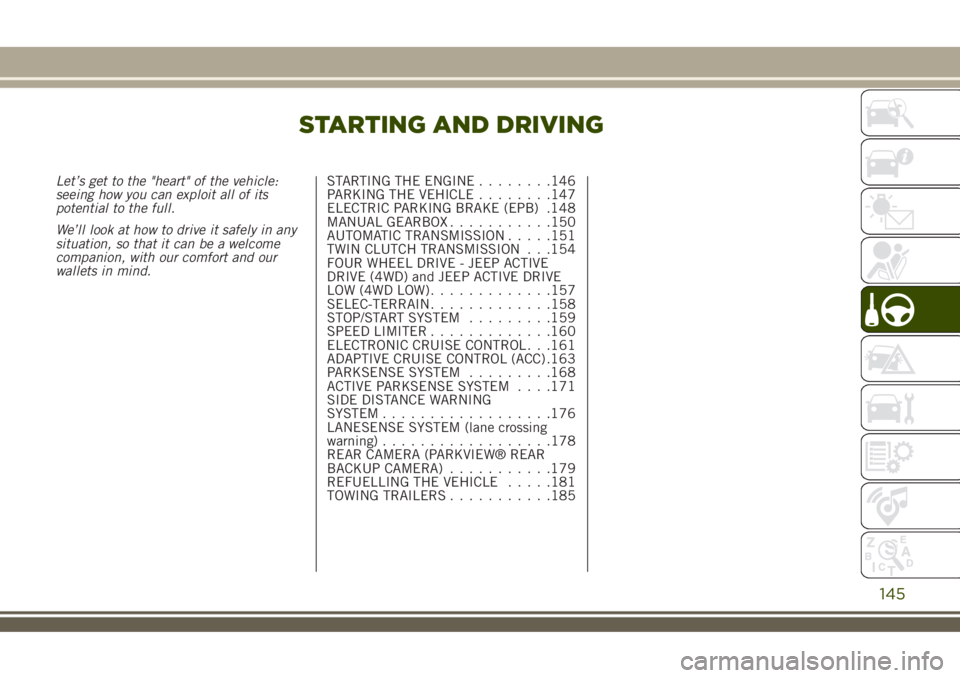
STARTING AND DRIVING
Let’s get to the "heart" of the vehicle:
seeing how you can exploit all of its
potential to the full.
We’ll look at how to drive it safely in any
situation, so that it can be a welcome
companion, with our comfort and our
wallets in mind.STARTING THE ENGINE........146
PARKING THE VEHICLE........147
ELECTRIC PARKING BRAKE (EPB) .148
MANUAL GEARBOX...........150
AUTOMATIC TRANSMISSION.....151
TWIN CLUTCH TRANSMISSION . . .154
FOUR WHEEL DRIVE - JEEP ACTIVE
DRIVE (4WD) and JEEP ACTIVE DRIVE
LOW (4WD LOW).............157
SELEC-TERRAIN.............158
STOP/START SYSTEM.........159
SPEED LIMITER.............160
ELECTRONIC CRUISE CONTROL . . .161
ADAPTIVE CRUISE CONTROL (ACC) .163
PARKSENSE SYSTEM.........168
ACTIVE PARKSENSE SYSTEM. . . .171
SIDE DISTANCE WARNING
SYSTEM..................176
LANESENSE SYSTEM (lane crossing
warning)..................178
REAR CAMERA (PARKVIEW® REAR
BACKUP CAMERA)...........179
REFUELLING THE VEHICLE.....181
TOWING TRAILERS...........185
145